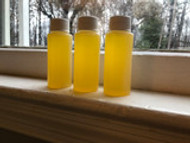Nine Myths About Linseed Oil and Flaxseed Oil
12th Jun 2020
After some not-so-polite disagreements on Facebook about linseed oil, we decided to publish a primer on our favorite oil and why our customers like it, too. As always, we welcome questions and comments submitted through our website or on Facebook and Instagram.
1. Linseed Oil Is Different From Flaxseed Oil
Nope. It’s the same product from the same part of the same plant—the seeds of Linum usitatissimum. It’s the same plant that produces flax, which is woven into linen cloth. It all comes down to a funny habit of the English language to maintain two words for the same plant or animal, one from French/Latin (in this case "linen" and the “lin” in linseed) and another from Old English/Germanic languages (flax). Often the words have different connotations and uses, such as mutton and sheep. In this case, “linseed oil” typically describes the product used for art and wood finishing, while “flaxseed oil” is commonly used in the U.S. for the food product.
2. Linseed Oil Is No Better for Wood Than Olive, Soybean or Any Other Oil
Wrong. Linseed oil is one of several “drying oils” that convert to a polymer in the presence of oxygen. This happens slowly, and obviously not to the same degree of hardening as varnish or epoxy, but it's enough to create a light finish that rests right on the outer part of the wood grain. Artists’ oil paints have traditionally been based on linseed oil. It’s also vital for cricket bats, as we learned from our customers.
3. Linseed Oil Is for Painters, Not for the Kitchen
Not exactly. It’s true that raw linseed oil is sold in hardware stores for adding to paint or wood finishing, and those cans of oil may not be suitable for cutting boards or consumption. Yet linseed oil can be used in the kitchen as long as it’s made in a food-safe process, not an industrial process that could leave chemical residue. Read the fine print on websites and product information. For example, this company says its popular linseed oil shouldn’t be used on cutting boards, so best to keep it out of your kitchen and dining room.
4. Linseed Oil Contains Dangerous Plant Toxins
Not really. It’s true that various solid food supplements made from flaxseed can contain appreciable amounts of chemicals related to cyanide, but that’s also true for other common plant materials used as food and shouldn’t be a problem if consumed as part of a healthy, balanced diet. Anyway, in scientific studies it’s whole crushed linseed—not the oil—that has typically raised eyebrows for containing cyanogenic glycosides. (https://www.efsa.europa.eu/sites/default/files/consultation/consultation/181127-ag.pdf)
5. Linseed Oil Smells Bad
No, the better types of cold-pressed linseed oil have a very mild scent, almost unnoticeable compared with industrial varieties, which often have a fairly significant nutty aroma or even a chemical scent. Boiled linseed oil, on the other hand, smells faintly of artists’ paints. The flavor of linseed oil is affected by its readiness to combine with oxygen, so some describe the taste of not-so-fresh oil as rancid. Scandinavians and others apparently celebrate the flavor as a traditional part of their diet. If you’re using good oil on cutting boards, wiping off the excess and letting it dry then you’re probably not going to notice any extra taste or flavor at all in your food.
6. Mineral Oil Is Better Than Plant Oils for Wooden Spoons and Cutting Boards
No, it really depends on the plant oil. Linseed oil and other drying plant oils are very suitable for wooden kitchenware. In fact, many people avoid mineral oil and paraffin because they’re derived from petroleum. Still, all are based on the same family hydrocarbons.
7. Boiled Linseed Oil Is Just Cooked Flaxseed Oil
Not always. Usually “boiled linseed oil,” as opposed to raw linseed oil contains poisonous metal-based drying catalysts used to speed up the drying of linseed oil for paints and finishes. A few companies, including Treeboard, sell a boiled linseed oil that’s actually produced by heating linseed oil, making it polymerized, or partially turned into a plastic-like solid. This is the only type of boiled linseed oil that’s suitable for kitchen applications.
8. Unlike Varnish, Linseed Oil Doesn’t Affect Wood’s Appearance
Not true. Linseed oil, especially the raw variety, seeps into the grain of wood and darkens it, especially over time. Usually this is very desirable, but if you prefer light-colored wood then choose another oil.
9. There’s No Need to Oil My Butcher Blocks and Wooden Spoons
Please oil your wooden kitchenware! Oiling wood, which is always porous to some degree, helps keep out liquids and food that could harbor bacteria. Cycles of deep wetting and drying can crack wood and ruin your kitchen heirloom. Oiling is especially important for the end grain (the side of the wood that can absorb the most liquid). Check out our tips for keeping your cutting boards clean.
Made in the U.S., Treeboard’s raw linseed oil is a 100% cold-pressed linseed/flaxseed oil that’s perfect for kitchen products, safe for food, nearly odorless and edible. The boiled linseed oil that we sell contains no driers or other chemicals and is safe to use on kitchenware.

